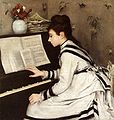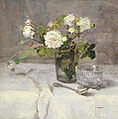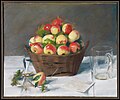Eva Gonzalès
Eva Gonzalès | |
|---|---|
 Eva Gonzalès (1849–1883) | |
| Born | April 19, 1849 Paris, France |
| Died | May 6, 1883 (aged 34) Paris, France |
| Nationality | French |
| Known for | Painting |
Notable work | Une loge aux Théâtre des Italiens (1874) |
| Movement | Impressionism |
| Spouse(s) | Henri Guérard (m. 1879) |

Eva Gonzalès (April 19, 1849 – May 6, 1883) was a French Impressionist painter.
Early life[]
Eva Gonzalès was born in Paris and became introduced to sophisticated literary and art circles at an early age by her father, writer Emmanuel Gonzalès.[1][2] In 1865, at age sixteen, Eva Gonzales began her professional training and art lessons in drawing from the society portraitist Charles Chaplin.[3] Through her father's connections as a founding president of the Société des gens de lettres, she met a variety of members of the Parisian cultural elite, and from a young age was exposed to the new ideas surrounding art and literature at the time.[4]
Student of Édouard Manet[]
Gonzalès is best known for her starting out as a pupil of the artist Édouard Manet in February 1869.[5] This relationship was formed by poor reviews that Manet received about his Salon entries, which made him hesitant to openly discuss his work; however, something about Eva's presence brought Manet out of his shell. Manet is said to have begun a portrait of her at once, which was completed in March 1870 and exhibited as Mlle E.G. at the Paris Salon in that year. Unfortunately, her debut submissions to the Salon, also in 1870, were overshadowed by the presence of Manet's portrait. In the Portrait of Eva Gonzales, Manet depicts her working at an easel, yet her stiff posture and expensive dress are clearly unfit for creating artwork. This depiction of her likely caused some critics to perceive her simply as a young, decorative model who was working with an older established male painter. Gonzalès was Manet's only formal student and also modeled for several members of the Impressionist school.[2] Manet's Mlle E.G. was discussed more than Gonzalès' oeuvre at her own 1885 retrospective and at the Galerie Daber's exhibition for her work in 1950.[6]
Gonzales' style aligns very closely to that of Manet's Spanish period, slight changes were made through the years as her forms of art consisted of discipline with a sober palette. The subjects she chose to use, were a representation of everyday life, that was deeply transpired by being under Manet's guidance.
During 1871, Manet pursued the incorporation of the more brilliant colors and active surfaces of the Impressionists within his work. Meanwhile, Gonzales decided to retain the neutral color schemes and precise contours of the sixties, while leaving her pastels in softer tones that created a lighter palette for her to work with. Gonzales' work may not be regarded as innovative, but it still holds charm and a sense of sincere personal expression that gives it significant value. Despite her association of being one of Manet's student, her work still carries meaning and progressing in the direction that perfectly aligned with her temperament.
Career and later life[]
Gonzalès' work was celebrated by Salon reviewers for the inherent intuition with which she approached art, as well as her technical skill.[4] At one point she listed herself as a student of Charles Chaplin with her submissions to the Salon, perhaps as a method to be taken more seriously. Much of her work became characterized through Salon reviews with the discussion of her "feminine technique" and her "seductive harmony." However, her large-scale painting, Box at the Théâtre des Italiens (1874), was characterized by the Salon jury as having "masculine vigor," which led them to reject it with questions as to her painting's authenticity.[3] Nevertheless, her work was reviewed positively by a variety of critics. Louis Leroy, Jules Castagnary, and Émile Zola praised the work she successfully showed at the Salons.[4] Furthermore, the art critic Maria Deraismes championed Gonzalés for producing paintings which challenged the way female painters were viewed and separated from the art scene in Paris.[7]
Like Édouard Manet, Gonzalès never exhibited in the Impressionist exhibitions in Paris, but she is considered part of the group because of her painting style. While studying under Manet, Gonzalès' self-portraits suggest that she was exploring her individuality and identity as an artist by presenting subtle correctives to Manet's version of her. Until 1872, she was strongly influenced by Manet but later developed her own, more personal style. This can be seen in works such as Enfant de Troupe (1870), which is a nod to Manet's Le Fifre (1866), while many of her later paintings involved portraits of her sister, Jeanne.[8] It was common of Gonzales to use her family members, particularly her husband and her sister, Jeanne Gonzalès, as models in her work.[8]
In 1879, after a three-year engagement, she married Henri Guérard, a graphic artist and Manet's engraver.[2] The couple had a son named Jean Raimond in April 1883, shortly before receiving news of the death of Manet. During the Franco-Prussian War she sought refuge in Dieppe.[3]
Her work was exhibited at the offices of the art review L'Art in 1882[2] and at the Galerie Georges Petit in 1883.
Death[]
In 1883, Gonzelès died in childbirth at the age of thirty-four,[1] five days after the death of her teacher, Edouard Manet,[9] which left her son to be raised by his father and her sister, Jeanne, who later became Guerard's second wife. Since her death, exhibitions of Gonzales work were held at the Salons de La Vie Moderne (1885), the Salon d'Automne (1907), at several galleries in Paris.[2] Her work has also been exhibited in 1952 at the Musée National des Beaux-Arts, Monte Carlo.
Accomplishments[]
Eva Gonzales' paintings have been purchased by the French government along with private collectors. Out of all her works, the broadest representation of her oeuvre can be spotted in the collection of her son and his heirs.
Some other accomplishments that she has had throughout her career, include the newspaper L'Art purchasing her pastels and receiving recognition in England, Belgium, and France.
Bibliography[]
Bayle, Paule, "Eva Gonzales," La Renaissance, June 1932.
Mathey, Francois, Six femmes peintres, Paris, 1951, 8.
Monaco, Eva Gonzales exposition, catalog by Claude Roger -Marx, 1952.
Moreau- Nelaton, E.., Manet raconte par luimeme, Paris, 1926, I.
Paris, Salons de la Vie Moderne, Catalogue des peinntures et pastels de Eva Gonzales, preface by Philippe Burty, essay by Theodore de Banville, 1885.
Paris, Galerie Bernheim- Jeune, Eva Gonzales, 1914.
Paris, Galerie Marcel Bernheim, Eva Gonzales, exposition retrospective, catalog by Paul Bayle, 1932.
Paris, Galerie Daber, Eva Gonzales retrospective, catalog by Alfred Daber, 1959.
Roger-Marx, Claude, Eva Gonzales, short essay by Theodore de Banville, Paris, 1950.
Little Soldier
Exhibitions:
Salon of 1870: Eva Gonzales retrospective,
Galerire Daber, Paris, 1959.
Literature:
Karl Berrand, " Salon de 1870," L' artiste,
April–June 1870, 319; Roger-Marx, n.p.,
Rewald, 240-41 and note 4, 268; Genevieve Lacambre and Jacqueline Rohan-Chabot, Le Musee de Luxembourg en 1874, Paris, 1974.
Gallery[]

Lady with a Fan, 1869–70
Enfant de troupe (The Little Soldier), 1870

L'Indolence, 1871–72

La jeune élève (Portrait of Sister as Artist) 1871-72

Plage de Dieppe, vue depuis la falaise Ouest ( Dieppe Beach towards the west cliffs), 1871

L'Avant Port (Dieppe) ( The Front Port), c. 1871
Une loge aux Théâtre Italiens, 1874

Le petit lever (The Little Lever), 1875

Morning Awakening, 1876

Nounou avec enfant ( Nanny with a child), 1877–78

Secretly, 1877–78

The Milliner, c. 1877

La Toilette, 1879

Portrait of a Woman in White, 1879

Woman in White, 1879

White Shoes, 1879–80

Reading in the Forest, 1880

Afternoon Tea, or On the Terrace, 1875

The Donkey Ride, 1880

Roses dans un verre( Roses in a Glass), 1880-82

Portrait of Jeanne Gonzalès in Profile

Pommes d'Api ( Sweet Apples), 1877-78
Selected Exhibitions[]
| Selected Eva Gonzalès Solo Exhibitions | Date |
| Paris, Salons de la Vie moderne. Catalogue des peintres et pastels de Eva Gonzalès. | 1885, January |
| Paris, Galerie Berhneim-Jeune. Eva Gonzalès. | 1914, March-April |
| Paris, Galerie Marcel Bernheim. Eva Gonzalès, retrospective. | 1932. June 20 - July 9 |
| Paris, Alfred Daber. Eva Gonzalès. | 1950. March 10 - April 1 |
| Principauté de Monaco. Sporting. Eva Gonzalès. | 1952, March 3 - 23 |
| Paris. Galerie Daber. Eva Gonzalès retrospective. | 1959, May 28 - June 3 |
| Also had many group exhibitions, often with Berthe Morisot and Mary Cassatt. |
References[]
- ^ Jump up to: a b Heller, Nancy G. (1987). Women Artists. New York: Abbeville Press. p. 94.
- ^ Jump up to: a b c d e Clement, Russell T.; Houze, Annick; Erbolato-Ramsey, Christiane (2000). The Women Impressionists: A Sourcebook. Westport, CT: Greenwood Press. p. 165.
- ^ Jump up to: a b c Gaze, Delia, ed. (1997). Dictionary of Women Artists. Chicago: Fitzroy Dearborn Publishers. pp. 596–599.
- ^ Jump up to: a b c Fine, Elsa Honig (1978). Women & Art: A History of Women Painters and Sculptors from the Renaissance to the 20th Century. Montclair, NJ: Allanheld & Schram. OCLC 3415319.
- ^ "Edouard Manet, Eva Gonzalès". National Gallery, London. Retrieved 10 October 2016.
- ^ Emmer, Janalee. "Rethinking Self: Eva Gonzalès (1849-1883) On Her Own" (PDF). Ohio Wesleyan University. Retrieved 7 March 2015.
- ^ Boime, Albert (1994). "Maria Deraismes and Eva Gonzalès: A Feminist Critique of 'Une Loge aux Théâtre des Italiens'". Woman's Art Journal. 15 (2): 31–37. doi:10.2307/1358602. JSTOR 1358602.
- ^ Jump up to: a b Riding, Alan (28 October 1993). "3 Artists Who Left A Fainter Impression". The New York Times. Retrieved 8 March 2017.
- ^ Weidemann, Christiane; Larass, Petra; Klier, Melanie, eds. (2008). 50 Women Artists You Should Know. Munich: Prestel. OCLC 195744889.
Further reading[]
- Marie-Caroline Sainsaulieu and Jacques de Mons. Eva Gonzalès: 1849-1883: Étude critique et catalogue raisonné. Paris, 1990.
- Marianne Delafond. Les femmes impressionnistes: Mary Cassatt, Eva Gonzalès, Berthe Morisot. Paris. 1993. ISBN 2-85047-227-1.
- Nochlin, Linda and Harris- Sutherland, Ann . Women Artists 1550-1950 pg 246–248.
- Elisabeth Jacquet. Eva Gonzalès/Rencontre avec une jeune femme moderne, L’Atelier Contemporain, 2020[1]
External links[]
| Wikimedia Commons has media related to Eva Gonzalès. |
- 1849 births
- 1883 deaths
- Burials at Montmartre Cemetery
- 19th-century French painters
- French people of Spanish descent
- French women painters
- French Impressionist painters
- Artists from Paris
- Deaths in childbirth
- French artists' models
- 19th-century French women artists





















